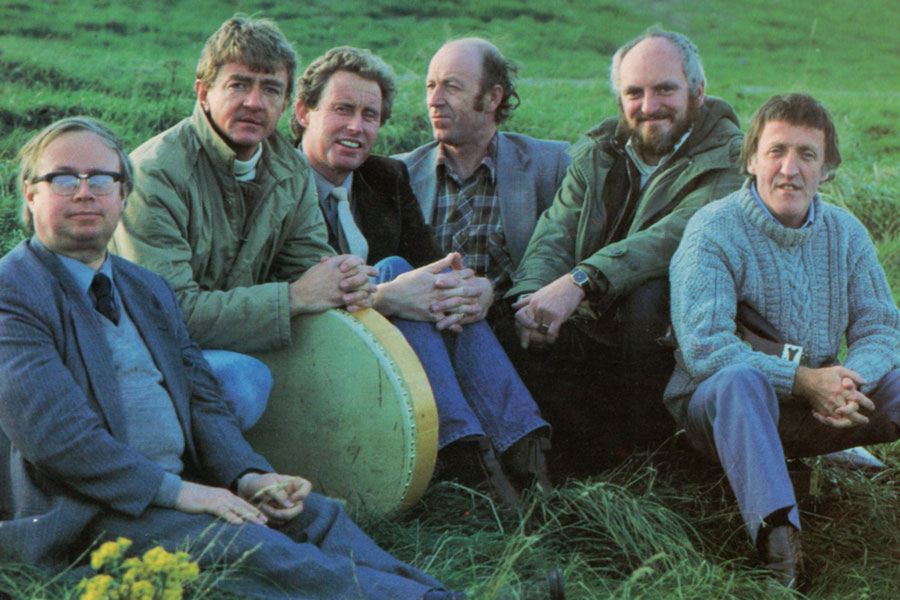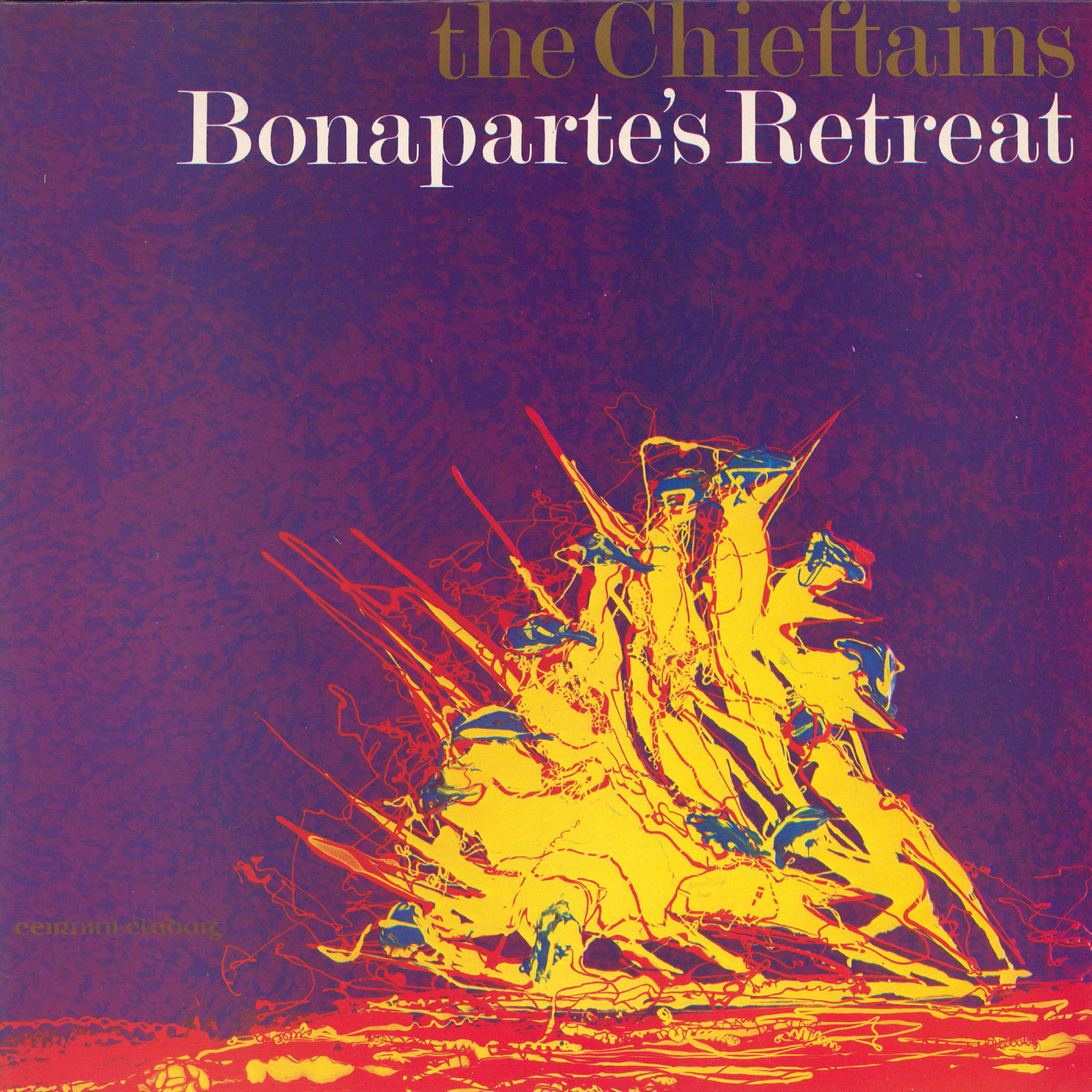


Sleeve Notes
The Chattering Magpie — This record begins with a selection of reels, The Dunmore Lassies and The Pigeon on the Gate, followed by a slip jig, Top it Off, which is then played as a reel. The latter grows to a climax featuring the whole group playing The Chattering Magpie.
An Chéad Mháirt den Fhomhar (The First Tuesday of Autumn) and Green Grow the Rushes O — In an Chéad Mháirt den Fhomhar Seamus Ó Domhnaill laments the death of his son Paidí in 1811. The boy was bringing home by boat a sack of fermented malt to make poitín, but was drowned off the Donegal coast at Gweedore. It is followed by Green Grow the Rushes O, which is normally played as a Schottische but is here played in reel time.
Bonaparte's Retreat — This amazing collage commences with a lament for the apparent total destruction of Gaelic civilisation represented by the flight of The Wild Geese, the chieftains of Gaelic Ireland and their followers, who after 1601 were forced to leave Ireland forever and take service in European armies, especially that of France. This slow air evokes, in the image of sails dwindling from Ireland's shores, the defeat of a people which was however in the form of the Wild Geese to become a strand in the history of Napoleon. This strand is the theme of Bonaparte's Retreat.Z The slow lament for the Irish exiles is followed by a verse from The Green Linnet, an Irish song rendered by Dolores Keane which hauntingly predicts, in the metaphor of the green linnet, Napoleon's destruction and also captures the force of his personality over those he touched:
Curiosity led a young native of Erin,
To view the gay banks of the Rhine,
Where an Empress he saw and the gold that she was wearing
All over with diamonds did shine.
No goddess in splendour was ever yet seen,
To equal this fair maid so mild and serene,
In soft accents she cried, O my linnet so green,
Sweet Boney, will I e'er see you more?
This is followed by a vivid description, in a version of The Bonny Bunch of Roses, of Napoleon's ruthless march to power, made more potent by a distant echo of The Marseillaise. The bonny bunch of roses was, of course, the ultimate prize which Napoleon never succeeded in winning — England, Ireland and Scotland. The Irish thread is pursued with Madam Bonaparte, a contemporary set dance composed in homage to the Empress Josephine.
The Court of the Emperor and Empress is now vividly evoked in an excerpt from the finale (or second movement) of Bochsa's Harp Concerto No. 1 in D Minor,Op. 15. Bochsa was appointed harper to Napoleon in 1813 and then, after his downfall, to Louis XVIII. He created modern technique on the double-action pedal harp, the instrument still found in modern orchestras. It is curious to note that the concert harp saw the pinnacle of its development in the France of Napoleon.
The military theme is renewed suddenly with a composition of Paddy Moloney's, The March to Victory, inspired by the successful campaigns of the Grand Armee. This is followed by the Irish set dance, Bonaparte's Retreat, in which the defeated but not yet destroyed French army begins its retreat from Moscow. Behind the orderly tread of the retreat the thud of the bodhrán and the ghostly rattle of the bones are a premonition of the horror soon to grip the French soldiers in the white wastes of the Russian winter.
Dolores Keane enters again with a verse of The Bonny Bunch of Roses:
He took three hundred thousand men
And kings likewise to bear his train,
He was so well provided for,
That he could sweep the world for gain;
But when he came to Moscow
He was over powered by the sleet and snow
With Moscow all a-blazing.
And he lost the bonny bunch of roses-o,
The Dozen fall of Paris, an echo of the defeated Marseillaise, is a set dance which in Paddy Moloney's version evokes the collapse of the Empire. The lament for Napoleon's destruction is again taken up by Dolores Keane in another verse from The Green Linnet:
I have travelled the desert of wild Abyssinia
But could find no relief for my pain,
Shall I go and enquire on the isle of St. Helena?
O no, I should whisper in vain.
Come tell me you critics, come tell me in time
What nation should I roam my green linnet for to find?
Did he die in Waterloo or on the banks of the Rhine
Or did he die on St. Helena's bleak shore?
The Chieftains take up the air of The Green Linnet to conclude in an evocation of the failure of repeated French attempts to help Ireland in her struggle for lost liberty. Ireland's hope of French help faded with the exile and death of Napoleon and the restoration of the Bourbon monarchy.
Away with Ye — Side two begins with a selection of three tunes: Ask me Father; Casadh an tSúgáín (The Twisting of the Rope), a spirited rendition of the well-known song describing the subtle ejection of an eager lover. The lady whose favours he is anxious to obtain cunningly enlists his assistance in twisting a hay rope, which as it grows longer compels him to retreat through the door, which she then slams.Z (A slow version of this tune may be heard on the Chieftains' first record, Island Records ILPS 9364) the selection ends, appropriately perhaps, with Old Hag; You Have Killed Me.
Caledonia — Máirséail Alasdroim and Langstrom's Pony are possessed of a tincture or two of Scottish spirit and certainly reflect the rich cross fertilisation between Irish and Scottish harpers and pipers. At the battle of Knockinoss in 1647 a party of Scottish Highlanders under Alasdair (Colkitto) MacDonnel, which fought on the Irish side, was butchered by the English or Parliamentary forces under Lord Inchiquin. Colkitto's funeral march was headed by a band of pipers playing what has since been called Máirseáil Alasdroim, a different version of which may be heard on Seán Keane's record Gusty's Frolics, (Claddagh Records CC17.) An alternative title for Langstrom's Pony is The Fourpenny Girl.
Iníon Nic Diarmada (Miss MacDermott) or The Princess Royal, Maire Dhall (Blind Mary) and John Drury — The first of three pieces by Carolan Iníon Nic Diarmada (Miss MacDermott) or The Princess Royal, was probably composed in honour of the daughter of his patrons.Z This and the next tune, Máire Dhall (Blind Mary), feature a metal-strung harp which resembles the O'ffogerty harp of 1650. The sound, therefore, should be close to the harp of Carolan's time. Máire Dhall was a harper for whom, it is held, Carolan composed the piece, a solo version of which may be heard on Derek Bell's record of Carolan's music Carolan's receipt (Claddagh Records cc18). John Drury was written to celebrate the marriage of John Drury of Kingsland, Co. Roscommon, to Elizabeth Goldsmith in 1724.
The Rights of Man — The Rights of Man is a hornpipe composed in honour of Thomas Paine's historical treatise refuting Burke's Reflections on the Revolution in France. Paine defended the revolution, in particular the adoption of the Declaration of the Rights of Man by the National Assembly. The tune reflects the respect felt by defeated Ireland for the aspirations to freedom embodied in Paine's treatise, aspirations not to be realised in Ireland for another 120 years.
Round the House and Mind the Dresser — Round the House and Mind the Dresser is the traditional warning to dancers to avoid crashing into the delft and furniture. It is therefore an appropriate title for these Kerry slides, especially as it is the first time dancers were invited by the Chieftains to participate in a recording. Six were invited; thirty turned up, and, although there was only room for ten on the floor these whacked into their job with a happy vengeance.
Garech de Brún and Richard Ryan